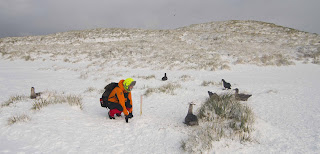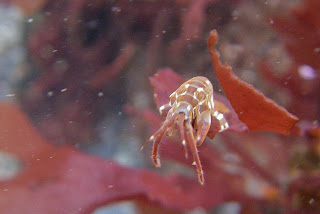As autumn draws on back home the days are getting longer on Bird Island. The last week has seen snow, rain, mist and blue skies, though with tremendous wind speeds we pass through each of them several times a day.
 |
| Brown Skua taking advantage of a warmer spell when the stream melted to have a good wash. The skuas have returned in their dozens in the last fortnight. |
As the island wakes up from winter my main field-work begins again.
 |
| With the ground still too frozen to build nests the Gentoos spend their time preening, resting and quarrelling. |
In my last blog I talked about the returning penguins. Large numbers of Gentoos are now regularly on the nesting beaches, but there has been relatively little nest-building activity. With temperatures still regularly below 0C they can't pick up pebbles, sticks or bones from the frozen mud so they've had to be satisfied with longer courtship rituals (mainly bowing to each other) and wandering around getting distracted by snow and each others tail feathers.
 |
| Northern Giant Petrel. The proud owner of a new egg. |
The bulk of my work now is with the Giant Petrels, the Geeps. There's a study area over the Meadows and each day I have to wander around looking for new nests and checking for any failures. I mark each nest with a stake and give it a number and record the location on GPS so I can create a map later.
 |
| Southern Giant Petrels trying to create their own egg. |
I try and get ring numbers for the birds and ring any unringed individuals, depending on how calm they are – with a beak superbly well adapted for ripping up dead seals and cetaceans they can and have inflicted some serious cuts and bruises to my hands and arms. The best protection during this sort of encounter is the leg of a welly (with the boot cut off) slid over the arm to act as a makeshift gauntlet. The ringed birds give us all sorts of long-term data including population changes, survival rates, chick-rearing success and long-term fidelity. One of the new nesters today was ringed as a chick in 1979, making her older than me. The old birds are generally more calm and relaxed and it's a privilege to sit near them eating lunch and counting how much we have in common (not that much was my conclusion).
 |
| Wandering Albatross chick sporting that 'mutton chop' look. |
 |
| With their adult feathers showing through the down the Wandering Albatross chicks are keen to feel the wind blowing through their wings, even though it'll be a bit of time before they can fly. |
As Steph's work ringing all the Wanderer chicks nears completion the first of the mollymawks, the smaller albatrosses, have returned and daily counts of them, along with more ring checking, have begun. The Grey-heads were first, followed by the Black-brows and the Light-mantled Sooties won't be too far off.
 |
| One of the first Grey-headed Albatrosses back at the colony. |
And the seals?
 |
| The smelliest bean-bag you've ever seen. |
As the craziness of the Fur Seal pupping season approaches Hannah is still recording Leopard Seal activity and desperately hoping for an Elephant Seal pup on Bird Island. There's a handful of enormous males on the beaches and a couple of females. We've got our fingers crossed.
 |
| Count the chins. |
The Elephant Seals are amazing. They look like the sort of thing that used to exist a hundred years ago, before the Victorians wiped them out so we could just look at poorly-drawn sketches and think 'nah... as if'. As they don't really breed here we're not going to get to see any of those spectacular fights between males but seeing the sheer size of them, and of their mouths when they're bellowing across the bay, gives the place a sense of pre-human wilderness.
 |
| Deserving the name elephant. |
In the midst of the Leopard / Elephant / Fur Seal watching there was even more exciting seal action with a second Weddell of the season. And this one was hauled out on Main Bay, far from home but enjoying the bitter weather.
 |
| Lovely small-faced Weddell Seal |
Longer days mean heading out earlier is possible, and getting work done quickly meant we could be done in time to create cakes and costumes for Hannah's birthday.
 |
| New superheroes and villains: Lord Caveman, Jesus riding an Orca, Dr Hogface and Super Binman. |
Jerry.























